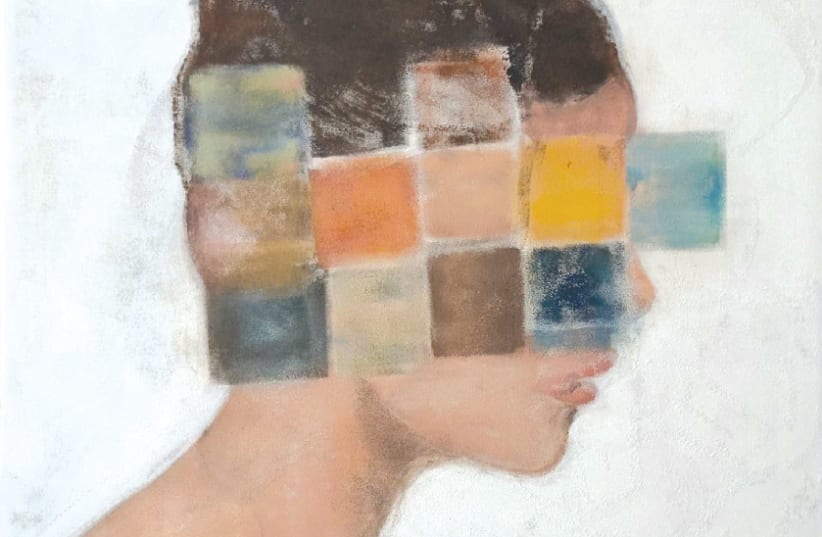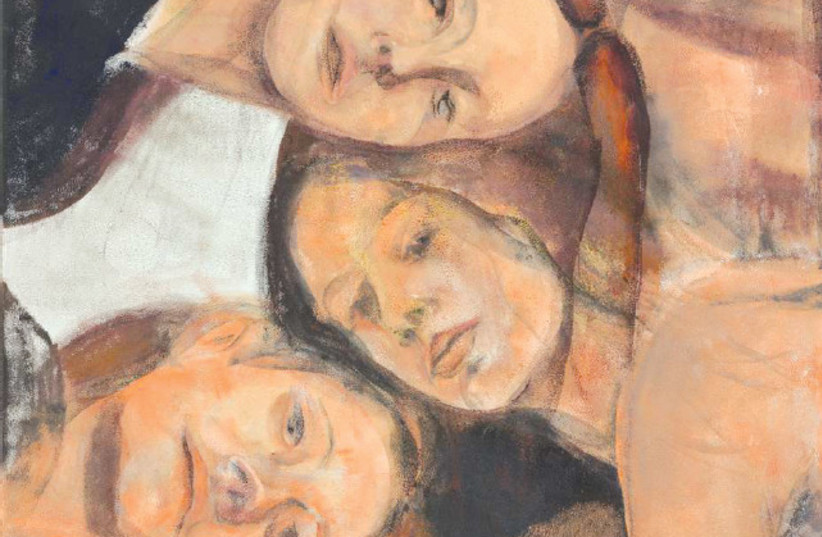Eran Shakine has a quizzical handle on interpersonal relations, or the lack thereof. That is patently clear from his Convergence exhibition of paintings currently on show at the Hezi Cohen gallery in Tel Aviv.
The canvases on the walls of the airy display facility explore the interface – or convergence – between juxtaposed areas of contemporary life and the increasingly indeterminate delineation between the virtual and the tangible-human, and the anonymous and intimate. Shakine digs into the detritus of actual face-to-face exchanges in a world in which many of us “meet” via Zoom, and “communicate” via social media.
In a scene in Monty Python’s most successful film, Life of Brian, the title character, desperate to avoid becoming an unwilling guru, tells the enormous crowd gathered outside his home that they need to think for themselves and not blindly follow someone they have anointed as their leader. In response, they simply repeat his advice, in perfect unison, “We are all individuals.” That ludicrous, wonderfully satirical state of affairs resonates in Convergence, albeit in a far less comic manner.
That mindset comes across in all the oil paintings, the majority of which feature groups of people, predominantly youngsters. A few characters appear to be communicating, or attempting to communicate, on the most intimate level, while others look like they are oblivious to their human surroundings.
Shakine feeds off both those arenas in his personal life. While, as an artist, he necessarily has to draw on the physical and emotional reality, out on the street he generally creates within the cloistered cocoon of his windowless studio in Tel Aviv.
“Most of these paintings were made over the past two, two and a half years,” he notes. “There were all the protests about the political regime here. That interaction has always fascinated me.”
Turning pain and suffering into art
Some of the works were the inadvertent result of the horrors inflicted on us on October 7.
Early that fateful morning Shakine and his partner were sitting on a plane awaiting takeoff to Paris, before continuing on to London. Shakine had various meetings lined up relating to future exhibitions. Like many of us, he could not possibly grasp the enormity of the seismic shift in life here and, betwixt texting with his daughter in Tel Aviv, after landing in Paris, to get updates on where we were at here, he decided to continue on to Berlin for a few days. There, he shut himself away from reality in a sporadically used nightclub, owned by a friend of a friend, and painted.
Convergence is very much a yin-yang take on life, with Shakine flitting between the corporeal and the ethereal.
“I am interested in what goes on in social media and the place of the person within super modern society. And now there is all this AI stuff,” he states.
He is also keenly concerned about where his own craft is headed.
“You get all this AI which you can use to create ‘perfect’ things. But where are the emotions?” he exclaims. Indeed. Perhaps there will soon be apps that can replicate, and even anticipate, the way people feel. We are already subjected to social and emotional conditioning on a massive and ever more invasive scale.
Fear-mongering appears to be the name of the political and hugely financially advantageous game, and it is the upcoming generations that are bearing the brunt of that. “Look at the figures in my paintings,” Shakine remarks. “The vast majority are youngsters. Where are they? Where are their feelings?”
There is very little in the way of overt emotion in Shakine’s subjects. There are plenty of opaque faces and blank stares in the scenes. They seem lost. And there is an underlying sense of latent trepidation waiting to erupt.
Shakine keeps to a very narrow color spectrum, ranging from greys to black with the odd very pale blue. There are also a couple of redheads among the figures who drift by, in seemingly aimless motion. Most of the works are displayed across the two long walls of the gallery, generating a sense of a bustling, yet muffled, street ambiance. You, the viewer, become party to the soporific numbed masses blindly shuffling along, occasionally reaching out for some physical and emotional contact.
That state of suspended neutrality and alienation is exacerbated by Shakine’s miserly use of oils, producing thin layers of paint to which he intermittently applies an industrial sponge roller. That adds a feral element to an already menacingly dystopian scene, with the meagerness of the painted strata implying the flatness of a cell phone or computer screen, the favored means of communication and social interaction of young people and, let’s face it, most of the rest of us.
In his curator’s notes, Yaniv Shapira cites 20th-century Viennese-born, multiple Nobel Prize nominee, Israeli philosopher Martin Buber and his musings about “I and thou.” According to Buber, social exchanges are based on what he termed two “primary words,” I-You and I-It. One wonders what the celebrated thinker would have made of social dynamics in the 21st century.
Convergence closes on July 13.For more information: hezicohengallery.com/













